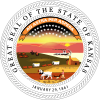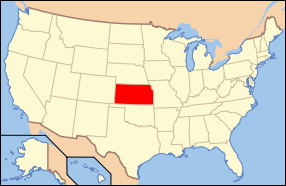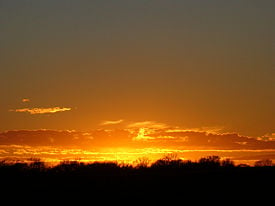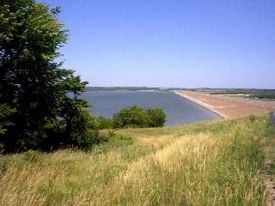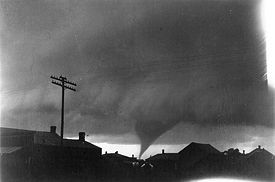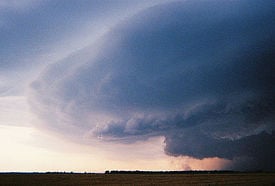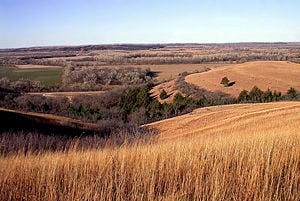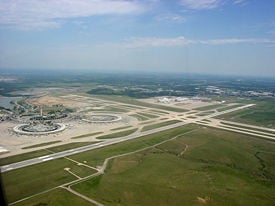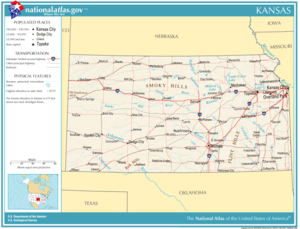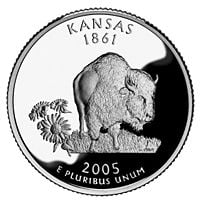Kansas
| State of Kansas | |||||||||||
| |||||||||||
| Official language(s) | English[1] | ||||||||||
| Capital | Topeka | ||||||||||
| Largest city | Wichita | ||||||||||
| Largest metro area | Kansas portion of Kansas City, MO-KS Metro Area | ||||||||||
| Area | Ranked 15th | ||||||||||
| - Total | 82,277 sq mi (213,096 km²) | ||||||||||
| - Width | 417 miles (645 km) | ||||||||||
| - Length | 211 miles (340 km) | ||||||||||
| - % water | 0.56 | ||||||||||
| - Latitude | 37° N to 40° N | ||||||||||
| - Longitude | 94° 35′ W to 102° 3′ W | ||||||||||
| Population | Ranked 35th in the U.S. | ||||||||||
| - Total | 2,913,123 (2017 est.)[2] | ||||||||||
| - Density | 34.9/sq mi (13.5/km2) Ranked 40th in the U.S. | ||||||||||
| - Median income | $50,177 (25th) | ||||||||||
| Elevation | |||||||||||
| - Highest point | Mount Sunflower[3][4] 4,041 ft (1232 m) | ||||||||||
| - Mean | 2,000 ft (610 m) | ||||||||||
| - Lowest point | Verdigris River at Oklahoma border[3][4] 679 ft (207 m) | ||||||||||
| Admission to Union | January 29, 1861 (34th) | ||||||||||
| Governor | Sam Brownback (R) | ||||||||||
| Lieutenant Governor | Jeff Colyer (R) | ||||||||||
| U.S. Senators | Pat Roberts (R) Jerry Moran (R) | ||||||||||
| Time zones | |||||||||||
| - most of state | Central: UTC-6/-5 | ||||||||||
| - 4 western counties | Mountain: UTC-7/-6 | ||||||||||
| Abbreviations | KS US-KS | ||||||||||
| Web site | www.kansas.gov | ||||||||||
Kansas is a Midwestern state located in the geographic center of the 48 contiguous states of the U.S.. commonly, and affectionately, referred to as the "Heartland." Millions of years ago, the area that is now Kansas served as the floor of an inland sea. Its soil, built by animal and vegetable matter from that sea, is among the most fertile in the world. Northeast Kansas is glaciated, formed from wind–blown glacial silt, with meandering streams, eroded valleys, and scattered glacial till, deposits of glacial activity a million years ago.
Originally, home to large numbers of nomadic Native Americans that hunted bison, it was first settled by white Americans in the 1850s, in the midst of political wars over the slavery issue. When officially opened to settlement by the U.S. government in 1854, abolitionists from New England and pro-slavery settlers from neighboring Missouri rushed to the territory to help decide the fate of Kansas; whether it would become a slave state or free. Thus, the area was a hotbed of violence and chaos in its early days as these forces collided; prior to the American Civil War, the eastern border of the state became known as Bleeding Kansas. On January 29, 1861, Kansas entered the Union as a free state.
One hundred years later, Kansas was again in the forefront of civil rights for African-Americans, as school de-segregation was instituted following the historic Brown v. Board of Education decision in the city of Topeka.
Today, Kansas is one of the most productive agricultural states, leading the nation in wheat and sunflower production. Politically and socially, it is a conservative state.
Etymology
Kansas takes its name from the Kansa (or Kanza) Indian Tribe. It is an old Siouan word meaning "Wind People" or "People of the South Wind." [5] Though there were numerous tribes in the territory at the time of the first European exploration of the area, the Kansa tribe were settled on the banks of the Missouri River, which forms only the northernmost border (75 miles) between Kansas and Missouri.
Residents of Kansas are called "Kansans."
Geography
Kansas is bordered by Nebraska on the north; Missouri on the east; Oklahoma on the south; and Colorado on the west. The state is divided into 105 counties and includes 628 cities. It is located equidistant from the Pacific and the Atlantic oceans.
The geographic center of the 48 contiguous states, located in Smith County, is marked by a limestone shaft and a flag located in a pasture near the town of Lebanon. The geodetic (magnetic) center of North America was located in Osborne County until 1983. This spot was until then used as the central reference point for all maps of North America produced by the U.S. government. The geographic center of Kansas is located in Barton County. Kansas is also one of the six states located on the Frontier Strip and one of several within Tornado Alley.
Millions of years ago, the area that is now Kansas served as the floor of an inland sea. Its soil, built by animal and vegetable matter from that sea, is among the most fertile in the world. Prehistoric fossils are abundant and can be found on an afternoon outing to the Flint Hills, or on a simple stroll through a neighborhood park.
Topography
The western two thirds of the state, lying in the great central plain of the United States, has a generally flat or undulating surface, and on a large scale appears almost perfectly flat and treeless. [6] These western plains, however, are home to some striking geologic formations. "Horse Thief Canyon" (a miniature of the Grand Canyon) is in the west, as well as are "Monument Rocks," which resemble sphinxes. "Castle Rock" are chalk spires which rise high above the surrounding level land. The entire state is dotted with gullies, which are a product of ancient erosion. On the eastern side of the state, the gullies are often filled with streams and lined with trees.
The land displays a gradual upward slope from east to west; its altitude above the sea ranges from 684 feet (208 m) along the Verdigris River in Montgomery County in the southeast, to 4039 feet (1,231 m) at Mount Sunflower, one half mile from the Colorado border, in Wallace County.
The eastern third of the state is hillier and forested. Springs are abundant. The southeast consists of the foothills of the Ozark Mountains (Missouri). "Gypsum Hills" lie in southwest Kansas, with the "Flint Hills" stretching from north to south in the east central section. The Flint Hills, gently rolling with few trees, are covered with bluestem, and are considered the only true prairie remaining in the nation.
The Missouri River forms nearly 75 miles (120 km) of the state's northeastern boundary with Missouri. The Kansas River (locally known as the Kaw), formed by the junction of the Smoky Hill and Republican rivers at appropriately-named town of Junction City, joins the Missouri at Kansas City, after a course of 170 miles (274 km) across the northeastern part of the state. The Arkansas River, rising in Colorado, flows with a bending course for nearly 500 miles (800 km) across the western and southern parts of the state. It forms, with its tributaries the Little Arkansas (pronounced Ar-Kansas), Ninnescah, Walnut, Cow Creek, Cimarron, Verdigris, and the Neosho rivers, the southern drainage system of the state. Other important rivers are the Saline and Solomon, tributaries of the Smoky Hill River; the Big Blue, Delaware, and Wakarusa, which flow into the Kansas River; and the Marais des Cygnes, a tributary of the Missouri River.
Climate
Kansas experiences extremes of weather, so much so that weather is part of a Kansan's identity. Family folklore often swirls around such things as tornadoes, droughts, floods, prairie fires, ice storms, and extreme heat. In recent years, efforts to understand and adapt to nature, rather than the futile attempt to control it, have been undertaken. [7]
There are three climate types spread across the state: humid continental, semiarid steppe, and humid subtropical. The eastern two-thirds of the state has a humid continental climate, with great extremes between summer and winter temperatures but few long periods of extreme hot or cold. Summers are very hot.
The western third of the state has a semiarid steppe climate, receiving an average of approximately 16 inches (40 cm) of precipitation per year. Chinook winds in the winter can warm western Kansas into the 80 degree Fahrenheit (25 °C) range.
The far south-central and southeastern reaches of the state have a humid subtropical climate, with long, hot summers, short, mild winters, and more precipitation than the rest of the state.
The annual average temperature is 55 °F (13 °C). The growing season ranges from mid-April to mid-September.
Precipitation ranges from about 46 inches (1200 mm) annually in the southeast of the state, to about 16 inches (400 mm) in the southwest. Snowfall ranges from around 5 inches (130 mm) in the fringes of the south, to 35 inches (900 mm) in the far northwest.
Located in what is known as Tornado Alley, Kansas experiences an average of over 50 tornadoes annually. According to statistics from the National Climatic Data Center, Kansas reported more tornadoes (for the period 1st January 1950 through to 31st October 2006) than any state except Texas. It has also - along with Alabama - reported more F5 tornadoes than any other state, the most powerful of all tornadoes. [8]
History
Located on the eastern edge of the Great Plains, Kansas was the home of nomadic Native American tribes who hunted the vast herds of bison.
European Influx
In 1541, Francisco Vasquez de Coronado, the Spanish conquistador, explored the unknown land now known as Kansas. Coronado's expedition introduced the horse to the Plains Indians, radically altering their lifestyle and range. Following this transformation, the Kansa (sometimes Kaw) and Osage Nation (originally Ouasash) arrived in Kansas in the 1600s. By the end of the 18th century, these two tribes were dominant in the eastern part of the state; the Kansa on the Kansas River to the North and the Osage on the Arkansas River to the South. At the same time, the Pawnees (sometimes Paneassa) were dominant on the plains to the west and north of the Kansa and Osage nations, in regions home to massive herds of buffalo. Europeans visited the Northern Pawnee in 1719. The French commander at Fort Orleans, Etienne de Bourgmont, visited the Kansas River in 1724 and established a trading post there, near the main Kansa village at the mouth of the river. Around the same time, the Otoe tribe of the Sioux also inhabited various areas around the northeast corner of Kansas.
In 1803, most of modern Kansas was secured by the United States as part of the Louisiana Purchase. Southwest Kansas, however, was still a part of Spain, Mexico, and the Republic of Texas until the conclusion of the Mexican-American War in 1848. From 1812 to 1821, Kansas was part of the Missouri Territory. The Santa Fe Trail traversed Kansas from 1821 to 1880, transporting manufactured goods from Missouri and silver and furs from Santa Fe, New Mexico. Wagon ruts from the trail are still visible in the prairie today.
Indian Territory
| Important dates in Kansas's history |
|---|
More... |
Beginning in the 1820s, the area that would become Kansas (by then popularly, but incorrectly, known as the Great American Desert) was "permanently" set aside as Indian territory by the U.S. government, and was closed to settlement by whites.
To fully utilize Indian territory, the U.S. government resettled Native American tribes already present in eastern Kansas, principally the Kansa and Osage, opening land to move eastern tribes into the area. By treaty dated June 3, 1825, 20 million acres (81,000 km²) of land was ceded by the Kansa Nation to the United States, and the Kansa tribe was thereafter limited to a specific reservation in northeast Kansas. [9] In the same month, the Osage Nation was limited to a reservation in southeast Kansas. [10]
The Missouri Shawanoes (or Shawnees) were the first Native Americans removed to the territory. By treaty made at St. Louis, on November 7, 1825, the United States agreed to provide:
- "the Shawanoe tribe of Indians within the State of Missouri, for themselves, and for those of the same nation now residing in Ohio who may hereafter emigrate to the west of the Mississippi, a tract of land equal to fifty miles [80 km] square, situated west of the State of Missouri, and within the purchase lately made from the Osage." [11]
The Delawares came to Kansas by the treaty of September 24, 1829, which described:
- "the country in the fork of the Kansas and Missouri Rivers, extending up the Kansas River to the Kansas (Indian's) line, and up the Missouri River to Camp Leavenworth, and thence by a line drawn westerly, leaving a space ten miles wide, north of the Kansas boundary line, for an outlet." [12]
The Indian Removal Act of 1830 expedited the process of transferring the Native tribes from their traditional lands of settlement to Indian Territory.
- By treaty dated August 30, 1831, the Ottawa ceded land to the United States and moved to a small reservation on the Kansas River and its branches. [13] The treaty was ratified April 6, 1832.
- On October 24, 1832, the U.S. government moved the Kickapoo to a reservation in northeast Kansas. [14]
- On October 29, 1832, the Piankeshaws and Weas agreed to occupy 250 sections of land, bounded on the north by the Shawanoes; east by the western boundary line of Missouri; and west by the Kaskaskias and Peorias. [15]
- By treaty made with the United States on September 21, 1833, the Otoe tribe ceded their country south of the Little Nemaha River. [16]
- By September 17, 1836 the confederacy of the Sac and Fox, by treaty with the U.S., moved north of the Kickapoo tribe into what later became the far nothereastern corner of the state of Kansas. [17]
- By treaty of February 11, 1837, the United States agreed to convey to the Potawatomi an area on the Osage River, southwest of the Missouri River [18]. The tract selected was in the southwest part of what is now Miami County, Kansas. In 1847, the Potawatomi were moved again, to an area containing 576,000 acres (2,330 km²), being the eastern part of the lands ceded to the U.S. by the Kansa tribe in 1846. This tract comprised a part of the present counties of Pottawatomie, Wabaunsee, Jackson and Shawnee.
- In 1842, after a treaty between the United States and the Wyandot Tribe, the Wyandot moved to the junction of the Kansas and Missouri Rivers, on land that was shared with the Delaware Tribe until 1843. [19] In an unusual provision, 35 Wyandot were given "Wyandot floats" in the 1842 treaty – ownership of sections of land that could be located anywhere west of the Missouri River.
By 1850 white Americans were illegally squatting on land in Indian Territory and clamoring for the entire area to be opened for settlement. Presaging events that were soon to come, several U.S. Army forts, including Fort Riley, were soon established deep in Indian Territory to guard travelers on the various Western trails. This was the first permanent settlement of white Americans in the future state of Kansas. Meanwhile, by the summer of 1853, it was clear that eastern Kansas would soon be opened to white American settlers. Accordingly, Congress sent George W. Manypenny, Commissioner of the Bureau of Indian Affairs, to negotiate new treaties with the various Native American tribes that would return to the U.S. Government all but a fraction of the land that, less than a quarter-century before, had been assigned to them "forever." Nearly all the tribes in the eastern part of the Territory ceded the greater part of their lands prior to the passage of the Kansas territorial act in 1854, and were eventually moved south to the future state of Oklahoma.
The Kansas-Nebraska Act
The concept of Manifest Destiny played a part in the formation of the Kansas-Nebraska Act of 1854. There were those, such as Senator Stephen A. Douglas of Illinois, who believed that the United States had both a right and obligation to take over as much land as possible and to spread its "civilizing" influence. He believed that those who stood in the way of the "advancement" of the U.S. should be removed.
The government planned to build a transcontinental railroad, especially following the discovery of gold in California. For such a railroad to be built, the territory of Nebraska had to be secured and organized. For this to take place, Native Americans would need to be removed from the territory.
Douglas needed sufficient votes to support the organization of Nebraska territory. To do so, he devised a plan to gain support from the Southern voters. He thus proposed a bill of re-organization of the Nebraska-Kansas territory which included the stipulation that the slavery question of the new territories created would be decided by popular sovereignty. Nebraska was far enough north that it's status as a free state would be secure. However, Kansas lay directly west of the state of Missouri, a slave state. [20]
On May 30, 1854 the Kansas-Nebraska Act became law, establishing the U.S. territories of Nebraska and Kansas and opened new lands for settlement. Kansas Territory stretched all the way to the Continental Divide, including what is now eastern Colorado. While not repealing the Missouri Compromise of 1820, the new law did deem it "inoperative and void." The act established that settlers could decide for themselves whether to allow slavery, in the name of "popular sovereignty" or rule of the people.
Unanticipated was the strong reaction within the Kansas Territory. The nation was divided, and the era known as Bleeding Kansas began.
Bleeding Kansas
“Bleeding Kansas” was a term coined by Horace Greeley of the New York Tribune to describe the violent hostilities on the eastern border of Kansas Territory following the establishment of the Kansas-Nebraska Act.
The controversial issue of the status of slavery in Kansas would have an impact on the make-up of the entire nation. In response, Kansas was flooded with three distinct groups: pro-slavers, free-staters and abolitionists, all coming to cast their vote for or against slavery. Citizens of southern states emigrated to the territory in order to secure the expansion of slavery, while anti-slavery organizations in the north organized to fund several thousand settlers to move to Kansas and vote to make it a free state.
Violence broke out among these rival groups, with kidnapping and tar–and–feathering eventually turning to raids and massacres along both sides of the border. Though a new territorial governor, John W. Geary, arrived in 1856 and was able to re-establish order, sporadic skirmishes continued till the end of the Civil War. Prominent players of this era were John Brown and William Quantrill.
When it came time to vote, only half the ballots were cast by registered voters, and at one location, only 20 of over 600 voters were legal residents. Several attempts at drafting a constitution were made, some versions were proslavery, others free state. Finally, a fourth convention met at Wyandotte in July 1859, and adopted a free state constitution and Kansas applied for admittance to the Union. Its admission was stalled due to the opposition of proslavery forces in the Senate. Only after the Confederate states seceded in 1861 was the constitution, and statehood, of Kansas approved. [21]
Expanded settlement
In 1879, upon the termination of the post-Civil War Reconstruction era in the South, a large number of former slaves moved from Southern states to Kansas. Known as the Exodusters, they were lured by the prospect of good, cheap land and better treatment. The town of Nicodemus, Kansas, which was founded in 1877, was an organized settlement that predates the Exodusters but is often associated with them.
At the same time, the Chisholm Trail was opened and the Wild West era commenced in Kansas. Wild Bill Hickok was a deputy marshal at Fort Riley and a marshal at Hays and Abilene. Dodge City was another wild cowboy town in the late 19th century. In one year alone, 8 million head of cattle from Texas boarded trains in Dodge City bound for the East, earning Dodge the nickname "Queen of the Cowtowns." Bat Masterson and Wyatt Earp were both lawmen in Dodge City.
On February 19, 1881, Kansas became the first U.S. state to adopt a Constitutional amendment prohibiting all alcoholic beverages. This action was part of the Temperance movement, and was enforced by the ax-toting Carrie Nation.
Recent history
On May 17, 1954, the Supreme Court in Brown v. Board of Education unanimously declared that separate educational facilities are "inherently unequal" and, as such, violate the 14th Amendment to the United States Constitution, which guarantees all citizens "equal protection of the laws." This landmark decision explicitly outlawed racial segregation of public education facilities (legal establishment of separate government-run schools for blacks and whites), ruling so on the grounds that the doctrine of "separate but equal" public education could never truly provide African Americans with facilities of the same standards available to white Americans.
At the time the suit was filed, only the elementary schools were segregated in Topeka; the high schools had been fully integrated since the late 1890s.
The former Monroe Elementary School in Topeka was designated as the Brown v. Board of Education National Historic Site on October 26, 1992 by the United States Congress to commemorate the landmark decision.
Law and government
Topeka is the capital of the State of Kansas and the county seat of Shawnee County, (named after the Native Shawnee Tribe). The city itself had a population of 122,377 as of the 2000 census. The Topeka Metropolitan Statistical Area, which includes Shawnee, Jackson, Jefferson, Osage, and Wabaunsee counties, had an estimated population of 226,268 in the year 2003.
In the northeast corner of the state, Topeka was one of the Free-State towns founded by antislavers immediately following the passage of the Kansas-Nebraska Act of 1854. In 1857, Topeka was chartered as a city and became the state's capital in 1861.
State and local politics
The top executives of the state are the Governor and Lieutenant Governor. Both officials are elected on the same ticket to a maximum of two consecutive four-year terms.
The legislative branch of the state government is the Kansas Legislature. The bicameral body consists of the Kansas House of Representatives, with 125 members serving two-year terms, and the Kansas Senate, with 40 members serving four-year terms.
Kansas has a reputation as a progressive state with many firsts in legislative initiatives:
- It was the first state to institute a system of workers compensation (1910).
- Kansas was one of the first states to permit universal women's suffrage in 1912. Suffrage in all states would not be guaranteed until ratification of the 19th Amendment to the U.S. Constitution in 1920. America's first woman mayor was elected in Kansas in 1887. It continues to rank high among the states in the proportion of women elected to public office.
- The council-manager government was adopted by many larger Kansas cities in the years following World War I while many American cities were being run by political machines or organized crime.
- Kansas was at the center of Brown v. Board of Education of Topeka, a 1954 Supreme Court decision that banned racially segregated schools throughout the U.S.
Since the 1960s, Kansas has grown more socially conservative. The 1990s brought new restrictions on abortion, the defeat of prominent Democrats, and the Kansas State Board of Education's 1999 decision to eliminate the theory of evolution from the state teaching standards, a decision that was later reversed. [22] In 2005, voters accepted a constitutional amendment to ban same-sex marriage. [23]
Although Kansas is considered to be one of the most Republican states in the nation, there has been a long-running feud between the socially moderate (or "mainstream") faction and the socially conservative faction of the party. This battle is so heated that it is often said that there are three parties in Kansas; Democrats, moderate Republicans and conservative Republicans. It is possible for a Democrat to win by winning the support of moderate Republicans and a few registered independents.
Federal politics
Kansas has not elected a Democrat to the U.S. Senate since 1932, when Franklin D. Roosevelt won his first term as President in the wake of the Great Depression. In 2007 its two U. S. senators were both Republicn, while there were two Democrat and two Republican Congressional Representatives.
Kansas has not supported a Democratic presidential candidate since 1964,when Lyndon B. Johnson won the state's electoral vote, and Republican candidates have carried Kansas in every election except one since 1940. In 2004, George W. Bush won the state's 6 electoral votes by an overwhelming margin of 25 percentage points with 62 percent of the vote.
Economy
The 2003 gross domestic product of Kansas was US$98 billion, an increase of 4.3 percent over the prior year, but trailing the national average increase of 4.8 percent. Its per-capita income was US$29,438. The December 2003 unemployment rate was 4.9 percent.
There are three income brackets for state income tax calculation, ranging from 3.5 to 6.45 percent. The state sales tax in Kansas is 5.3 percent. Various cities and counties in Kansas have an additional local sales tax.
Resources
Known for its abundant farmland, Kansas is also rich in mineral resources. It is one of the top 15 mineral-producing states. The state leads the nation in production of helium, and is a major producer of cement, stone, clay and its products, as well as sand, gravel, salt, and bituminous coal. The chalk supply in Kansas is virtually limitless. Kansas ranks 8th in the U.S. in both oil and natural gas production.
Agriculture and industry
Kansas' central location, as well as a strong labor force, makes for a healthy manufacturing climate. Ample electrical power and good source of water are also contributing factors to its healthy economy. Compulsory unionism is prohibited by a state right-to-work law. Revenue bonds are issued by most cities in the state in order to encourage new industry.
The city of Wichita, in south central Kansas, ranks first in the world in production of general aviation aircraft and is also central to the production of military aircraft.
Other items produced in the state are snowmobiles, camping gear, heating and air-conditioning equipment, mobile homes, tires, paint, dishwashers, publishing, prefabricated houses, apparel, food processing, and pet foods.
Major company headquarters in Kansas include the Sprint–Nextel Corporation and Embarq, both with with operational headquarters in the Kansas City suburb of Overland Park. National headquarters and major distribution facilities for Payless Shoes Corporation is in the capital city of Topeka. Pizza Hut was founded in Wichita.
Kansas ranks first in the nation in the production of wheat and sorghum grains. It is one of the top producers of cattle and processed beef and ranks high in the hog market. Additional agricultural outputs are sheep, soybeans, wild hay, cotton, corn, and salt.
Military
Kansas is home to several military facilities which contribute to its economy. McConnell Air Force Base at Wichita is a part of the Strategic Air Command and one of four bases in the nation to house the B-1B bomber.
Fort Leavenworth was established in 1827 as a major outpost while Kansas was Indian Territory and has been in continious operation. The Command and General Staff College on its grounds offers training to international military officers.
Fort Riley was established in 1853 as a military outpost. It is also an important infantry-training center and is home to the 1st Infantry Division.
Transportation
The only Kansas airport with transcontinental service is in Wichita, which is in the sourthern part of the state. However, Kansas City International Airport is slightly over the state line in Missouri and is easily accessible, and used, by residents of Kansas, Missouri, Iowa and Nebraska. Kansas City International was ranked No. 1 among medium-size airports in the J.D. Power and Associates 2007 North America Airport Satisfaction Study. The study considers an airport mid-size when it handles a capacity of 10 to 30 million passengers a year.
Kansas railroads are excellent for east-west travel but, except in the eastern part of the state, the north-south lines are inadequate.
There are two interstate highway systems, the east-west route of Interstate-70, which connects St. Louis, Missouri with Denver, Colorado, via Kansas City and Topeka in Kansas. Other cities along the route are the college towns of Lawrence and Manhattan, and the military town of Fort Riley. Interstate 35 is a major north-south route connecting to Des Moines, Iowa, in the north and Oklahoma City, Oklahoma, in the south.
Education
Education in Kansas is governed primarily by the Kansas State Board of Education. The Kansas school system became well-known for its stance on the teaching of evolution versus creationism. On August 9, 2005, the Board approved a draft of science curriculum standards that mandated equal time for the theories of "evolution" and "intelligent design" This echoes a previous decision in Kansas. In 1999, the Board ruled that instruction about evolution, the age of the Earth, and the origin of the universe was permitted, but not mandatory, and that those topics would not appear on state standardized tests. However, the Board reversed this decision February 14, 2001, ruling that instruction of all those topics was mandatory and that they would appear on standardized tests.
Higher education
The Kansas Board of Regents governs or supervises 37 public institutions. It also authorizes numerous private and out-of-state institutions to operate in the state. In Fall 2004 the state’s six public universities reported a combined enrollment of 88,270 students, of which almost a quarter were non-resident students and a tenth were off-campus enrollments.
Among the state-funded universities, the University of Kansas (KU) is the largest in terms of enrollment, with 26,980 at its Lawrence campus, KU Edwards Campus in Overland Park, and Public Management Center (formerly the Capitol Complex) in Topeka. The total university enrollment, which includes KU Medical Center, was 29,590. About 31 percent were non-resident students.
Kansas State University (KSU) has the second largest enrollment, with 23,151 students at its Manhattan and Salina campuses and Veterinary Medical Center. About 19 percent were non-resident students. Wichita State University (WSU) ranks third largest with 14,298 students; about 12% were non-resident students. WSU has lost nearly 3,000 students since the school dropped football following the 1986 season. Fort Hays State University (FHSU), Pittsburg State University (PSU), and Emporia State University (ESU) are smaller public universities with total enrollments of 8500, 6537, and 6194, respectively. FHSU has the fastest growing enrollment in Kansas with most of it coming from non-resident and off-campus enrollment. The composition of FHSU's enrollment includes 35 percent non-resident students and 44 percent off-campus enrollments. PSU also has almost a quarter of enrollment from non-residents.
Demographics
Kansas' population in 2006 was an estimated 2,764,075, which is an increase of 15,903, or 0.6 percent, from the prior year and an increase of 71,128, or 2.6 percent, since the year 2000. The largest reported ancestries in the state are: German (25.9 percet), Irish (11.5 percent), English (10.8 percent), American (8.8 percent), French (3.1 percent), and Swedish (2.4 percent). [24] In 2005, African-Americans comprised about 6.6 percent of the population while hispanics comprised approximately 7 percent, Asian or Pacific Islanders were 2.5 percent and Native American were 1.8 percent.These figures are somewhat deceptive, however, as much of the population claims mixed ancestry, which was not allowed for in the census.
Population distribution
The northeastern portion of the state is home to more than 1.1 million people in the Kansas City, Lawrence, Topeka, and St. Joseph metropolitan areas. Forty percent of the state's population is in the northeast corner. Johnson County, in the metropolitan Kansas City area has some of the fastest growing populations and highest median incomes, not only in the state but in the entire U.S. Two cities in Johnson County received high rankings in the 2006 Best Place to Live category by Money Magazine; Overland Park was ranked in 6th place, and Olathe came in at 13th. [25]
In south-central Kansas lies the city of Wichita, with a population of nearly 600,000. A major manufacturing center for the aircraft industry, it has earned the nickname 'The Air Capital'.
People of German ancestry are especially strong in the northwest, while those of British ancestry and descendants of white Americans from other states are especially strong in the southeast. Mexicans are present in the southwest and make up nearly half the population in certain counties. Many African Americans in Kansas are descended from the "Exodusters," newly freed blacks who fled the South for land in Kansas following the Civil War.
Miscellaneous topics
Historic sites
| Kansas State symbols |
|
Several historic places throughout the state include:
- Fort Leavenworth, north of the city of Leavenworth, is the oldest active Army post west of the Mississippi River.
- The city of Atchison was an early commercial center in the state and is well-known as the birthplace of Amelia Earhart.
- Kansas State University, located in the city of Manhattan, is the nation's oldest land-grant university, dating back to 1863.
- The small town of Newton was once western terminal of the Santa Fe Railroad and trailhead for the famed Chisholm Trail.
- The north-central historic city of Abilene was formerly a trailhead for the Chisholm Trail and was the boyhood home of President Dwight D. Eisenhower. The Eisenhower Library is there, as well as his grave.
- Southwest Kansas, and Dodge City in particular, is famously known for the cattle drive days of the late nineteenth century. The city of Dodge was built along the old Santa Fe Trail route.
- The John Brown museum is located in the town of Osawatomie.
- The house of Carrie Nation, now a museum, is located in historic Medicine Lodge.
- The Kansas Cosmosphere and Space Center, located in Hutchinson, is affiliated with the Smithsonian Institute. The museum features the largest collection of artifacts from the Russian Space Program outside of Moscow. It is also home to Apollo 13, an SR-71 Blackbird, and many space artifacts.
National Park Service sites
Areas under the protection of the National Park Service within the state include:
- Brown v. Board of Education National Historic Site in Topeka
- California National Historic Trail
- Fort Larned National Historic Site in Larned
- Fort Scott National Historic Site
- Lewis and Clark National Historic Trail
- Nicodemus National Historic Site at Nicodemus
- Oregon National Historic Trail
- Pony Express National Historic Trail
- Santa Fe National Historic Trail
- Tallgrass Prairie National Preserve near Strong City
Notable residents
Despite its strong agricultural reputation, Kansas was home to industrial and intellectual pioneers Walter Chrysler of automotive fame, Clyde Cessna & Lloyd Stearman (aviation), Jack Kilby (microchip inventor, The Nobel Prize Winner in Physics 2000), George Washington Carver (educator and scientist), Earl W. Sutherland, Jr. (The Nobel Prize Winner in Physiology or Medicine 1971), and Vernon L. Smith (The Nobel Prize Winner in Economics 2002).
Famous athletes from Kansas include Wilt Chamberlain, Barry Sanders, Gale Sayers, John H. Outland, Billy Mills, Jim Ryun, Walter Johnson, Jackie Stiles, Caroline Bruce, John Riggins, Maurice Greene, and Lynette Woodard. Kansas is also home to coaches James Naismith, Phog Allen, Dean Smith, Adolph Rupp, Tex Winter and Eddie Sutton.
No discussion of notable Kansas residents would be complete without mentioning the more famous fictional residents: Marshal Matt Dillon from the TV Show 'Gunsmoke', Dennis Mitchell (Dennis the Menace), Dean and Sam Winchester from the TV Show 'Supernatural', Dorothy from the Wizard of Oz, Clark Kent/Superman, as well as Mr. and Mrs. Bridge, are examples of some of the more famous fictional Kansas residents.
Notes
- ↑ Error on call to template:cite web: Parameters url and title must be specified. Us-english.org (2007-05-11).
- ↑ Kansas: Population estimates. U.S. Census Bureau (July 1, 2017). Retrieved May 6, 2017.
- ↑ 3.0 3.1 Elevations and Distances in the United States. United States Geological Survey (2001). Retrieved October 21, 2011.
- ↑ 4.0 4.1 Elevation adjusted to North American Vertical Datum of 1988.
- ↑ William E. Connelley, A Standard History of Kansas and Kansans, The KSGenWeb Project. Retrieved June 6, 2007.
- ↑ Mark Fonstad, William Pugatch, and Brandon Vogt. Kansas Is Flatter Than a Pancake, Annals of Improbable Research. Retrieved May 17, 2007.
- ↑ Kansas Museum of History. 2008. Forces of Nature Retrieved March 22, 2008.
- ↑ Weather/Climate Events, National Climatic Data Center. Retrieved June 6, 2007.
- ↑ Charles J. Kappler, Government Printing Office, 1904. TREATY WITH THE KANSA, 1825, Oklahoma State University Library. Retrieved June 7, 2007.
- ↑ Kappler, GPO, 1904. TREATY WITH THE OSAGE, 1825, Oklahoma State University Library. Retrieved June 7, 2007.
- ↑ Kappler, GPO, 1904. TREATY WITH THE SHAWNEE, 1825, Oklahoma State University Library. Retrieved June 7, 2007.
- ↑ Kappler, GPO, 1904. TREATY WITH THE DELEWARE, 1825, Oklahoma State University Library. Retrieved June 7, 2007.
- ↑ Kappler, GPO, 1904. TREATY WITH THE OTTAWA, 1831, Oklahoma State University Library. Retrieved June 7, 2007.
- ↑ Kappler, GPO, 1904. TREATY WITH THE KICKAPOO, 1832, Oklahoma State University Library. Retrieved June 7, 2007.
- ↑ Kappler, GPO, 1904. TREATY WITH THE PIANKESHAW, 1832, Oklahoma State University Library. Retrieved June 7, 2007.
- ↑ Kappler, GPO, 1904. TREATY WITH THE OTO AND MISSOURI, 1833., Oklahoma State University Library,
- ↑ Kappler, GPO, 1904. TREATY WITH THE SAUK AND FOXES, 1836, Oklahoma State University Library. Retrieved June 7, 2007.
- ↑ Kappler, GPO, 1904. TREATY WITH THE POTAWATOMI, 1837, Oklahoma State University Library. Retrieved June 7, 2007.
- ↑ Kappler, GPO, 1904. TREATY WITH THE WYANDOT, 1842, Oklahoma State University Library. Retrieved June 7, 2007.
- ↑ Bleeding Kansas, PBS Online. Retrieved June 10, 2007.
- ↑ Bleeding Kansas, Fort Scott National Historic Site. Retrieved June 10, 2007.
- ↑ Nicholas Riccardi. November 9, 2005. Vote by Kansas School Board Favors Evolution's Doubters, The Las Angeles Times. Retrieved June 10, 2007.
- ↑ Same Sex Marriage, National Center for State Courts. Retrieved June 10, 2007.
- ↑ U.S. Census Bureau. Kansas - Race and Hispanic Origin: 1860 to 1990.
- ↑ CNN Money.com. Best places to live 2006, Retrieved June 22, 2007.
Resources
- Central and Western Kansas, Karl Janssen Art and Design.
- Kansas Travel and Tourism, Keith Stokes' Kansas Travel. Retrieved June 5, 2007.
- Kansas Liquor Law. Kansas Legislative Research Center. Retrieved May 19, 2007.
- Enrollment Headcount at Kansas State Universities. Kansas Board of Regents. Retrieved May 19, 2007.
- Kansas QuickFacts. Geographic and demographic information from the U.S. Census Bureau. Retrieved May 19, 2007.
- Ingram, Scott. 2003. Kansas. From Sea to Shining Sea. New York: Children's Press. ISBN 051622395X
- Masters, Nancy Robinson. 1999. Kansas. America the beautiful. New York: Children's Press. ISBN 0516209930
- Stratton, Joanna L. 1981. Pioneer women: voices from the Kansas frontier. New York: Simon and Schuster. ISBN 0671226118
External links
All links retrieved October 4, 2022.
- Kansas. Leisure and Sport Review.
- Cutler, William G. History of the State of Kansas. Kansas Collection Books.
- Perry-Castañeda. Kansas Maps. The University of Texas at Austin.
- Publications and Reports. Kansas Department of Transportation.
- Kansas webcam directory. Live Webcam Site.
- Territorial Kansas. Kansas Heritage Group.
| Political divisions of the United States | |||||||
|---|---|---|---|---|---|---|---|
| |||||||
Credits
New World Encyclopedia writers and editors rewrote and completed the Wikipedia article in accordance with New World Encyclopedia standards. This article abides by terms of the Creative Commons CC-by-sa 3.0 License (CC-by-sa), which may be used and disseminated with proper attribution. Credit is due under the terms of this license that can reference both the New World Encyclopedia contributors and the selfless volunteer contributors of the Wikimedia Foundation. To cite this article click here for a list of acceptable citing formats.The history of earlier contributions by wikipedians is accessible to researchers here:
The history of this article since it was imported to New World Encyclopedia:
Note: Some restrictions may apply to use of individual images which are separately licensed.

